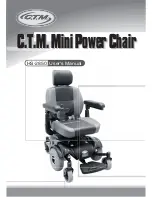
SALSA/SALSA M
69
Rev.5.0
13.6
Inspection of the upholstery/seating
Tears, dents, wearing or slackening of upholstery
particularly near to metal could result in poor posture or
lower levels of comfort and pressure relief.
13.7
Cleaning seating
You can wash all parts of the covers with a gentle-
•
wash detergent at 40°C.
You can spin-dry the covers.
•
CAUTION!
Do not dry the covers in a dryer.
You can remove all parts of the covers independently
•
of each other and wash them separately.
Take out the foam inlays prior to washing and close the
•
Velcro fasteners.
Where upholstery cannot be removed, clean regularly
•
to prevent build up or soiling.
Clean with a damp soapy cloth however disinfectants
•
may be used in dilution as specified by their
manufacturer. Ensure surfaces are rinsed well with
clean water and dried thoroughly.
WARNING
Do not use a hose or a pressure washer to clean your
chair.
Cleaning instructions for Comfort seating:
Clean regularly to prevent build up or soiling.
•
Clean with a damp soapy cloth and rinse well with
•
clean water.
Dry the surface thoroughly.
•
A soft brush with soapy water may be used to remove
•
stubborn dirt. Ensure surfaces are then rinsed and
dried.
Some chemical colourings, e.g. ball point pen, food
colourings or clothes dyes should be removed immediately
to prevent long term staining.
CAUTION!
Do not use solvents, bleaches, abrasives, synthetic
detergents, wax polishes or aerosols. Disinfectants may
be used in dilution as specified by their manufacturer.
Ensure surfaces are then rinsed with clean water and dried
thoroughly.
13.5 Cleaning your wheelchair
The wheelchair should be wiped over once per week with
a slightly damp, not wet, cloth and any fluff or dust that has
accumulated around the motors should be blown or dusted
away.
Make sure that you dry all parts of your wheelchair if it
becomes wet or damp after cleaning or if it is used in a wet
or damp atmosphere.
WARNING!
It is important that should the wheelchair be used by more
than one person it is cleaned thoroughly to ensure there is
no cross infection.
Fig.13.15
Fig.13.16
















































